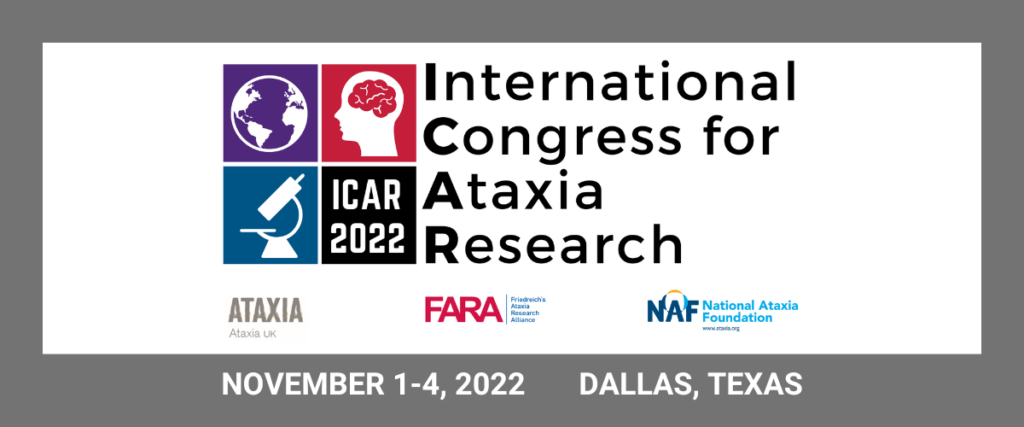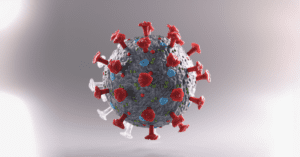
Written by Sarah Donofrio, with notes from Dr. Hayley McLoughlin
Edited by Hayley McLoughlin
On Wednesday morning, ICAR attendees heard talks covering a range of topics, all focused on research about the mechanisms and biomarkers of ataxia.
Wednesday morning began with the Disease Mechanisms Plenary. The session was kicked off by Dr. Jerome Honnorat, who described progress made in autoimmune and paraneoplastic ataxias. Notable findings included the identification of biomarkers for these diseases, the categorization of these ataxias according to the antibodies involved, and potential mechanisms including tumors, infections, and genetic mutations. Dr. Honnorat’s talk provided perspective on how far the field has come and where work still needs to be done. The next steps in autoimmune ataxia research involve recruiting large international cohorts, characterizing immune changes in patients, and conducting genetic studies and studies in animal models.
The next speaker was Dr. Meike van der Heijden, a postdoctoral fellow in the Sillitoe lab, who studies movement disorders using different mouse models. Dr. van der Heijden found that a certain cluster of neurons in the cerebellum fire in distinct patterns depending on the type of movement disorder. For example, in a mouse model of ataxia, the neurons fire at a steady rate, whereas in a tremor model, the neurons fire in regular bursts. The lab also found that making the neurons fire in each pattern induced the associated motor defect in otherwise normal mice. Dr. van der Heijden’s study presents a major step towards understanding the neuronal firing patterns that can cause different movement disorders, including ataxia.
Next, Dr. Marija Cvetanovic spoke about her research in a mouse model of spinocerebellar ataxia 1 (SCA1). Her group studied the relationship between Bergmann glia and Purkinje cells, two cerebellar cell types that interact and have been implicated in ataxia. Using a SCA1 mouse model, Dr. Cvetanovic found that altered calcium signaling in Bergmann glia decreases Purkinje cell firing and can improve motor deficits. These results show how different cells in the cerebellum interact to contribute to motor problems in ataxia.
The next speaker, Dr. Peter Todd, discussed the events that can cause abnormal protein production in Fragile X tremor-ataxia syndrome. His group found that genetic changes can trigger genetic mutations, activate stress pathways, and lead to the production of toxic protein aggregates. Dr. Todd’s work sheds light on how these different processes contribute to neurodegeneration in ataxia. In addition, some of these processes may be useful targets for therapies.
Dr. Monica Banez-Coronel, who studies toxic proteins in SCAs, gave the last talk in this session. She found that toxic proteins generated by RAN translation accumulate in patients with SCA1, 2, 3, 6, and 7 and that the affected brain regions are damaged. By using a drug to inhibit the accumulation of SCA3 toxic proteins, her group was able to decrease cell toxicity in an SCA3 cell model. Dr. Banez-Coronel’s results suggest that toxic RAN proteins are common in multiple SCAs and represent potential therapeutic targets.
After the Disease Mechanisms Plenary, conference participants could attend either the Disease Mechanisms II breakout session or the Biomarkers breakout session. In the Disease Mechanisms II session, Dr. Helene Puccio spoke about her work in a mouse model of autosomal recessive cerebellar ataxia 2 (ARCA2). She found that Purkinje cell degeneration in this model is caused by problems with mitochondria and calcium levels. By supplementing an enzyme that the mouse model lacks, her group was able to repair mitochondria and the calcium imbalance in Purkinje cells. This suggests that supplements of this enzyme may be a useful therapeutic for ARCA2.
Next, Mr. Logan Morrison, a graduate student in the Shakkottai lab, spoke about his work in a mouse model of SCA1. He studies a part of the brain called the inferior olive. In SCA1 mice, inferior olive neurons are more likely to fire than neurons in normal mice. The SCA1 inferior olive neurons are also larger and more complex than normal inferior olive neurons. According to Mr. Morrison, this suggests a similarity between SCA1 and a disease called hypertrophic olivary degeneration, which may mean that similar treatment strategies could be used in both.
Dr. Marie Coutelier then spoke about her work in people with mutations in a gene called SPG7, which can cause ataxia. Her group sequenced the genomes of patients with cerebellar ataxia and identified patients with rare mutations. Dr. Coutelier is currently investigating the effect of these mutations on DNA transcription. Her results emphasize the importance of genetic examination in people who are carriers for genes linked to ataxia.
Next, Dr. Chih-Chun Lin discussed a possible link between SCA35 and gluten ataxia. The protein TG6 is implicated in both ataxias. Dr. Lin found that deleting Tg6 in mice causes ataxia and that exposing normal mice to anti-TG6 antibodies interferes with potassium ion channels in Purkinje cells. Future experiments will include studying potassium channels in mice that lack Tg6. Dr. Lin suggests that if there is a connection between TG6 and potassium channels, then potassium channels may be a therapeutic target for both SCA35 and gluten ataxia.
Finally, flash talks in the Disease Mechanisms breakout session covered the following topics: molecular interactions that regulate the accumulation of toxic proteins in ataxia, correlations between genetic abnormalities and disease onset and severity, a role for a protein associated with Alzheimer’s disease in SCA1, and sex-specific muscle impairments in autosomal recessive spastic ataxia of Charlevoix-Saguenay (ARSACS).
At the same time as Disease Mechanisms II, the Biomarkers breakout session opened with Dr. Jorge Diogo Da Silva, who investigated using a bile acid to treat SCA3. His group found that the bile acid can improve motor function in a SCA3 mouse model, and they made headway into understanding how the bile acid exerts its beneficial effects. In addition, the protein that binds the bile acid is reduced in SCA3 patients. This means that the protein may serve as both a biomarker of disease and a therapeutic target.
Dr. Richard Festenstein spoke about technology his group developed to measure changes in movement in patients with Friedreich’s ataxia. The technology consists of biosensors that detect movement around the neck, elbow, hip, and knee. Data from the biosensors can predict frataxin levels better than the standard scale used by clinicians to assess ataxia. In the future, the biosensors will be used to assess movement during daily life tasks and determine how the data relates to common measurements of ataxia. Using this technology in clinical trials could mean shorter trials with fewer subjects, thereby making clinical trials more efficient.
Next, Dr. Clementina Mesaros talked about identifying metabolites that could serve as biomarkers of Friedreich’s ataxia. Her group identified metabolites that are reduced in patients and found that levels of the metabolites are correlated with frataxin levels. Therefore, measuring the levels of these metabolites in the blood could represent a way to monitor Friedreich’s ataxia in patients.
Dr. Sophie Tezenas du Montcel aimed to identify features that distinguish healthy patients from pre-ataxic patients and patients in early stage SCA1 and SCA3. Her group found that in SCA1 and SCA3 patients, pre-ataxic patients already had upper motor problems. In addition, neurofilament light chain (NfL) levels were higher in pre-ataxic patients compared to healthy patients and increased with ataxia severity. This suggests that upper motor problems and NfL levels can be used to identify ataxic patients before they develop ataxia.
Flash talks in the Biomarkers session covered the analysis of cerebrospinal fluid to find biomarkers in Friedreich’s ataxia, gait biomarkers to monitor the progression of SCA3, technology to assess upper limb ataxia, and the use of neuroimaging to track changes in Friedreich’s ataxia over time.
Keywords
Paraneoplastic ataxia: ataxia caused by a tumor.
Biomarker: a feature that can be measured to assess the presence, progression, or severity of a disease.
Antibody: a protein produced by the immune system that targets a specific foreign object, such as a bacterium or virus.
Cerebellum: a brain region involved in motor coordination and balance that is involved in ataxia.
Bergmann glia: cells in the cerebellum that exchange signals with Purkinje cells.
Purkinje cells: neurons in the cerebellum that undergo degeneration in many ataxias.
Mitochondria: organelles that produce energy for cells.
Inferior olive: a brain region involved in motor coordination and motor learning.
Ion channels: proteins that allow ions to pass into and out of a cell. Important for allowing neurons to fire signals.
Neurofilament light chain: protein found in neurons.
Cerebrospinal fluid: fluid that surrounds the brain and spinal cord.
About the Author and Editor
Sarah Donofrio is a graduate student at Baylor College of Medicine studying Purkinje cell degeneration in movement disorders. Sarah is a member of the Sillitoe laboratory, alongside Dr. Meike van der Heijden, who presented research in this session.
Dr. Hayley McLoughlin is an Assistant Professor in the University of Michigan Neurology Department, with a joint appointment in the Department of Human Genetics. Her lab currently focuses on establishing pathogenic mechanisms and therapeutic interventions for SCA3. She has no conflict of interest to declare regarding this session.

Los científicos desarrollan un nuevo enfoque para evaluar la Ataxia en casa
Escrito por Ziyang Zhao Editador por la Dra. Hayley McLoughlin Traducido por Ismael Araujo Aliaga Una aplicación para teléfonos inteligentes recientemente desarrollada permitirá a los pacientes evaluar la ataxia en casa. Existe Read More…

The SCA2 Chronicles: Unmasking COVID-19’s impact on Mind and Movement in a Galaxy Not So Far Away
Written by Kaitlyn Neuman Edited by Celeste Suart, PhD Lessons from a global pandemic: COVID-19 negatively impacts speech function and mental health in SCA2 patients. A short time ago, in a Read More…

Snapshot: O que é Distonia?
Distonia é uma desordem que afeta a maneira como uma pessoa se move. Mais especificamente, pessoas com distonia têm contrações musculares involuntárias, que podem causar posturas anormais. A distonia pode Read More…










